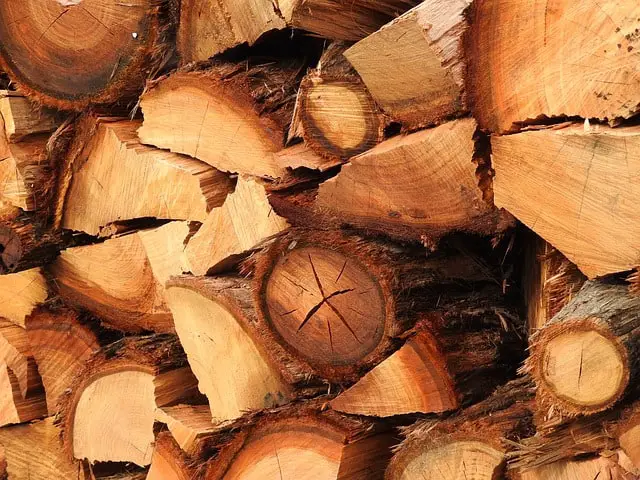Splitting firewood efficiently and safely is essential for maintaining a good supply of fuel for heating or cooking. There are several methods and tools you can use to split firewood, each with its benefits:
Axe
- Method: An axe is a classic tool for splitting firewood. Swing the axe with force, aiming for the center of the log’s grain to split it.
- Benefits: Axes are versatile and do not require power. They allow you to control the size of the split pieces.
Maul
- Method: A maul is a heavier and blunter splitting tool designed for larger logs. It is used similarly to an axe, but the weight of the maul provides more force.
- Benefits: Mauls are effective for splitting tough, large logs due to their weight and blunt edge. They require less precision and reduce the risk of glancing blows.
Wedge and Sledgehammer
- Method: Place a metal wedge into the log’s grain and use a sledgehammer to drive the wedge deeper into the wood, splitting it.
- Benefits: This method is effective for tough logs and offers good control over the splitting process.
Log Splitter (Manual)
- Method: A manual log splitter is a tool that uses hydraulic pressure to split logs. You operate a lever or foot pump to apply pressure.
- Benefits: Manual log splitters reduce physical effort, making splitting large quantities of wood easier and more efficient.
Log Splitter (Gas or Electric)
- Method: Gas or electric log splitters use a hydraulic system to split logs automatically. Simply place the log on the splitter and operate the controls.
- Benefits: These powered log splitters are ideal for heavy-duty use and can split large volumes of wood quickly and with minimal physical effort.
Chainsaw
- Method: A chainsaw can be used to make deep cuts into the log, creating wedges that facilitate splitting with an axe or maul.
- Benefits: Chainsaws speed up the initial cuts and are useful for large logs. They are versatile tools that can be used for other tasks as well.
Wood Splitting Machine (Kinetic)
- Method: Kinetic wood splitters use a flywheel and ram to split logs rapidly and efficiently.
- Benefits: These machines are incredibly fast and can split large quantities of wood with minimal effort. They are a good option for commercial or heavy use.
Benefits of Each Method
Here’s a table summarizing the different methods of splitting firewood, along with detailed benefits and considerations for each option:
| Splitting Method | Benefits | Considerations |
|---|---|---|
| Axes and Mauls | – Offers precise control over splitting. | – Requires physical effort. |
| – Suitable for small to medium logs. | – May be slow for large quantities. | |
| Wedge and Sledgehammer | – Effective for tough, knotty logs. | – Requires precision in wedge placement. |
| – Minimal risk of glancing blows. | – May be slower than other methods. | |
| Manual Log Splitters | – Reduces physical effort. | – Suitable for medium-sized logs. |
| – Safer than using a sledgehammer. | – Slower than powered options. | |
| Gas or Electric Log Splitters | – Ideal for heavy-duty use. | – Requires a power source (gas or electricity). |
| – Fast and efficient, great for large quantities. | – Initial cost and maintenance. | |
| Chainsaw | – Speeds up the initial cuts. | – Requires skill and safety precautions. |
| – Versatile tool for other tasks. | – May produce uneven splits. | |
| Kinetic Wood Splitters | – Incredibly fast and efficient. | – Higher initial cost. |
| – Excellent for commercial or heavy use. | – Requires a power source (electric or gas). |
The choice of method depends on your specific needs, physical abilities, and the volume of wood you need to split. Consider safety precautions and personal preferences when selecting the most suitable method for your situation.

The Easiest Woods To Split For Firewood
Not all woods are created equal. Some are easier to split and to even source in the first place. Here are woods that are generally easy to split for firewood:
- Softwoods:
- Pine: Pine wood is soft and typically has straight, even grains, making it relatively easy to split. It’s a popular choice for kindling.
- Cedar: Cedar wood is lightweight and has a natural resistance to splitting, making it easier to work with.
- Pine: Pine wood is soft and typically has straight, even grains, making it relatively easy to split. It’s a popular choice for kindling.
- Hardwoods:
- Aspen: Aspen wood is lightweight and has a relatively straight grain, which makes it easier to split.
- Poplar: Poplar wood is similar to aspen and is known for being easy to split.
- Aspen: Aspen wood is lightweight and has a relatively straight grain, which makes it easier to split.
- Fruitwoods:
- Cherry: Cherry wood is a hardwood with a relatively straightforward grain pattern, making it easier to split.
- Apple: Apple wood, like cherry, has a manageable grain and is suitable for splitting.
- Cherry: Cherry wood is a hardwood with a relatively straightforward grain pattern, making it easier to split.
- Sycamore: Sycamore wood is known for its interlocking grain, which can make it easier to split along the grain lines.
- Alder: Alder wood is relatively soft and easy to work with, making it a good choice for those looking for easy-splitting firewood.
It’s important to note that even within these wood types, the ease of splitting can vary based on factors such as the wood’s moisture content and the specific growth characteristics of the tree. To make splitting even easier, it’s recommended to properly season (dry) the wood, as seasoned wood is generally easier to split than green or wet wood.
Additionally, using the right tools and techniques, such as a maul or log splitter, can further simplify the splitting process.

